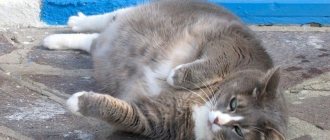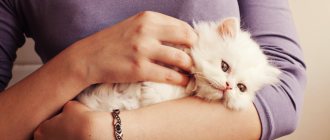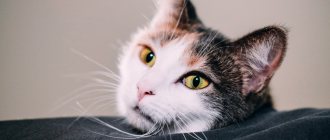How to determine pregnancy
Visually, a cat’s pregnancy can be suspected with an increase in the abdomen and appetite. It is imperative to see a doctor, because there are a number of pathologies that can also manifest themselves. And for further diagnosis, an ultrasound of the abdominal cavity will be required (1). Pregnancy can also be seen on x-rays.
1st – 3rd week of pregnancy in a cat
In the early stages it is very difficult to determine. Only at the beginning of the 3rd week is it possible to see something on an ultrasound, but the cat itself does not show any external signs of pregnancy. Therefore, you will be surprised by the middle of the term, when the cat begins to show obvious signs of motherhood.
4 – 6 weeks of pregnancy in a cat
Only at the beginning of this period does the cat’s nipples begin to change color and they swell.
Also, some cat mothers experience attacks of morning sickness during this period (just like in humans!).
Even during this period of pregnancy, the cat begins to gain weight, she becomes more affectionate and playful, and begins to demand more attention from her owners.
At week 5, the cat’s tummy enlarges and becomes denser.
7 – 9 weeks of pregnancy in a cat
At week 7, you can feel the kittens moving if you lightly put your hand on their tummy.
Don’t be afraid to touch and stroke a pregnant cat, because during such a period the cat really needs care and affection, and a person you can trust. And, of course, when kittens are already obvious in the stomach, your cat certainly cannot hide the pregnancy from you.
If you have a purebred cat and you really need to know about the onset of her pregnancy, the sooner the better, then already 2 weeks after the expected pregnancy occurs, you can take your cat for an ultrasound and the ultrasound will show whether there is a pregnancy.
At the end of the term
A couple of weeks before giving birth, the expectant mother looks for a convenient place, hidden from view, where she will give birth and feed the kittens. It is better if the owner arranges it himself and prepares everything necessary. Harbingers of imminent labor include discharge from the vulva, nipples, and drowsiness.
The cat gives birth approximately 2 months after fertilization by the male. It is advisable that the owner or a visiting veterinarian be with her at this time, especially for the first time. On the eve of birth, the pet’s body temperature drops and appetite worsens.
The birth of kittens begins with the breaking of water and subsequent contractions. It is necessary to ensure that the birth of each fetus does not take too long (maximum 5-6 hours).
After the process is completed, the mother and cubs need rest. It is advisable to provide all the conditions so that she does not have to go far from the “nest” - put food, water, and a litter tray nearby.
Caring for a pregnant cat
Pregnancy in a cat requires increased attention and proper care. Here are a few things to consider.
How to feed a cat during pregnancy
During pregnancy, cats should be given special food for pregnant and lactating cats. It contains all the necessary vitamins and microelements designed for bearing offspring.
– Already in the first weeks of pregnancy, the cat becomes less active, and its appetite increases. It is better not to limit the cat’s food intake at this time, just make sure that she does not gain excess weight. Play with her so that she moves more, recommends felinologist Elena Vishneva.
When feeding an animal with industrial feed, you can add nothing additional to the diet.
You should not change your diet suddenly, you just need to change to food from the same company that you fed, but special food for pregnant women or kittens, they are more enriched in composition than the usual everyday diet.
A natural diet in itself is wonderful, but any owner must approach the choice of such nutrition very seriously: how and how much and what to give to your pet, the required amount for its weight, for this it is necessary to calculate all the norms.
Therefore, during pregnancy, if all the norms of your natural nutrition are fully met, then, as a rule, it is enough just to increase the volume of the diet and increase the frequency of meals up to 4 times a day.
It is useful to add calcium to your diet, for example in the form of cottage cheese. Vitamin supplements should be administered with caution based on your cat's diet (complex vitamins from a pet store). For example, with an excess of vitamin A, mutations can occur in offspring. Additionally, the introduction of calcium in the form of drugs, if abruptly discontinued in a nursing cat, can lead to eclampsia (lack of calcium leading to convulsive phenomena). Hypercalcemia is fraught with a number of pathologies.
Is it possible to give medications to a pregnant cat?
There are a small number of medications and drugs that can be used during pregnancy, and only the doctor, and not the owner himself, should decide what medicine your pet needs.
And, despite the fact that the manufacturer’s instructions indicate whether the drug can be used or not during pregnancy or not, only a doctor can decide whether to give medication to your pet.
How to prepare for a cat giving birth
A week before giving birth, the cat begins to produce colostrum. It is noticeable by the dried droplets around the nipples. The animal's activity decreases, the cat sleeps more. By this time, we need to prepare a cozy nest for her, where she can hide and begin to prepare for childbirth.
“A day or two before giving birth, you need to spend more time with a pregnant cat: petting them, massaging their tummy,” advises Elena Vishneva.
Features of childbirth
Childbirth in cats is an individual process. Their duration depends on various factors:
- age;
- physiological state;
- number of births;
- animal breeds;
- living conditions and diet during pregnancy;
- hormonal status of the body;
- individual characteristics, etc.
On average, labor in cats lasts 12-36 hours. This time includes the preparatory period with contractions and pushing. It can last several hours or several days. Then labor begins. Kittens appear one by one. As a rule, between thirty minutes and several hours can pass between the birth of two kittens. But there are times when childbirth lasts a day or even several.
A cat needs human support during birth
There are no specific norms for cat labor. You need to proceed from your own experience and conditionally defined time frames. Contractions on average begin 10–12 hours before the onset of labor. The first contractions are the weakest. The break between them can be 30–40 minutes. During this period, the expectant mother can remain active, drink and eat. A characteristic sign that she is going into labor is that she stops sleeping. In the second stage, the body produces stimulating hormones that keep it awake.
The interval between the strongest contractions is 30–40 seconds. This indicates that the first kitten is already at the birth canal, and there is little time left before pushing. The norm is 2-3 attempts, then a kitten appears. After the first, the amniotic sac containing amniotic fluid comes out. They either burst on their own or are opened by a cat. Then one or two more attempts follow, after which the baby appears. Mom licks him, gnaws the umbilical cord and eats the afterbirth.
Normal time between kittens being born
The average time between the first contractions and the appearance of the offspring is approximately 12 hours. If more time has passed and the kittens do not appear, the help of a veterinarian is needed. If labor remains inactive for a long time, hypoxia may develop - oxygen starvation of the fetus. This can adversely affect the health of the offspring or be fatal.
The average duration of all stages is approximately 24 hours. Their duration is influenced by the number of kittens, the general health of the mother, and external factors. When a cat gives birth, the interval between the appearance of kittens is 15-30 minutes, sometimes it can increase to one hour. All this time, contractions will be repeated between attempts. The intervals between kittens during birth are usually the same.
The interval between the appearance of kittens makes it possible to get the babies in order
The cat gives birth too quickly
Childbirth is sometimes rapid: in this case, kittens come out very quickly. This deviation is considered the most dangerous compared to protracted labor. In the case of rapid labor, all offspring are born in just an hour. This can happen due to stress or miscarriage. Sometimes this can be hereditary. In such a situation, the cat experiences very strong pain due to the short intervals between contractions.
In this case, kittens are born almost without interruption; the cat does not have time or cannot properly lick the cubs or gnaw the umbilical cords, but can eat the placenta or even the kittens. This suggests that either the offspring are not viable, or a miscarriage has occurred.
In case of rapid birth, the kittens will have to be looked after by the owner
During rapid labor, human help is needed: to open the blisters as quickly as possible, clear the airways of fluid and mucus, and wipe the babies.
After this, you need to give the mother a little time so that she can calm down and try to attach the kittens to her nipples. Some cats calmly begin to feed. But there is a possibility that the pet will begin to hiss and growl at the kids. In this case, they will have to be fed by the owner, but they have very little chance of surviving on artificial feeding.
The cat is giving birth for too long
An inexperienced owner cannot always determine whether the birth process is normal. Therefore, it is important to know at what interval a cat gives birth to kittens. Labor is considered protracted and the cat needs help if:
- contractions started 12 hours ago, and the first baby has not yet appeared;
- the birth bubble appears, but there is no effort for 10-15 minutes;
- The first kitten was born more than an hour ago, and the next attempts have not begun.
After the babies appear, the cat licks the kittens and eats the afterbirth.
If the birth is protracted, the pet has more opportunities to save the life of her offspring. The owner must monitor how long it takes for the cat to give birth to the next kittens. Sometimes labor stops: not all babies have been born yet, but labor has stopped. This condition can persist for 36 hours. The animal’s behavior can be quite normal: eating, sleeping and other usual actions. When the body is ready, the birth process will begin again.
But such situations are rare. Most often this is associated with a loss of strength and indicates a forced cessation of the birth process. As a result, the fetus remaining inside dies, and toxins begin to enter the body. The same can happen if there are afterbirths inside.
What to do when giving birth to a cat
The first signs of the approaching birth are already visible when the kitty begins to fuss in her nest, her breathing quickens, she often licks herself, she begins to tremble and her pulse quickens. The cat senses our nervousness, so we need to calm it down with a gentle voice, pet it, and massage its tummy. Remove bright light.
– If labor pains continue for more than 24 hours, it is better to seek help from a veterinarian. You may need a caesarean section, says Elena Vishneva .
Before giving birth, a cat may change its behavior, “build a nest”, its nipples will swell, and before giving birth its body temperature may drop to 37 °C.
When a cat begins to give birth, the main thing is to provide her with comfortable, calm conditions, silence and not to disturb her. Most animals give birth on their own without any complications. In case something doesn't go according to plan, you need to have contacts for a veterinarian who can come to your home to help with the birth.
From medications you can stock up on calcium gluconate and Oxytocin. Childbirth can last up to 24 hours. The time between births of kittens can take up to several hours. During labor, you can stroke your cat's belly if it doesn't cause her discomfort.
If the kitten is stuck or does not come out head first, you need to help him get out - you need to gently pull the baby, not holding the paws, but the body or the skin on the withers. It is better if you do this with sterile hands or sterile gloves.
If the cat itself has not ruptured the amniotic sac, it is necessary to help her with this by carefully cutting it without harming the kitten.
The cat should initiate the kitten's breathing process by licking it. If she doesn't do this, you should encourage the kitten to breathe by stroking her back and rubbing her. You may even need to shake him upside down if he is breathing strangely (he may have inhaled amniotic fluid).
– It is also important to carefully monitor how many kittens and placenta are produced. And after the birth, with the help of a veterinarian, make sure that there is nothing left inside,” says veterinarian Marina Mikheenko.
How to understand that a cat has given birth to all kittens
Signs that labor has ended:
- the cat begins to actively care for the babies: lick and feed them;
- breathing is calm, heartbeat is regular;
- quite soon after the last kitten has appeared, the animal begins to feel intense hunger and thirst;
- leaves the nest for a short time;
- 30-40 minutes after the last kitten emerges, the belly feels soft to the touch, without compaction.
It should be noted that the abdomen does not always sharply decrease in volume, so its size cannot be an objective indicator of the termination of labor.
If the animal behaves calmly, this may not necessarily indicate that labor has ended. If you have any doubts, it is better to contact your veterinarian and do an ultrasound.
Newborn kittens are completely helpless
If there are suspicions that not all offspring have appeared, you need to pay attention to the behavior. There are a number of signs by which you can determine that the birth process has not completed:
- after the last kitten has appeared, the pet maintains its position, lies in the same position, there are no signs of activity;
- the animal reluctantly and inactively cares for the kittens, does not try to feed them and does not lick them;
- from time to time you can observe attempts; the animal may try to push out another fetus;
- the cat doesn’t want to eat or drink;
- a few hours after the last calf has appeared, the abdomen remains tense, hard, and increased muscle tone is felt;
- a day after the birth of the last kitten, the mother cat’s temperature remains above 39 degrees;
- After two days, bloody discharge with an unpleasant odor appears.
If these signs are observed, there is a high probability that a fetus remains in the uterus. Be sure to call a veterinarian to your home. The best option in this case would be ultrasound diagnostics. Do not ignore the examination, as this can save the animal’s life. However, it is best to prevent such situations and visit the clinic about a week before the expected due date. During the visit, the doctor will perform an ultrasound, and then the owner will have accurate information about how many babies should be born. Then all that remains is to arm yourself with a notepad and pen and write down how many babies and afterbirths have come out.
False pregnancy in cats
False pregnancy is a pathological condition of an animal in which it believes itself to be pregnant, but is not. In this case, all the signs of pregnancy may appear: nipples swell, colostrum is released, behavior changes, the cat may begin to build a nest.
This happens under the influence of the production of sex hormones. In advanced cases, an increased amount of colostrum can affect, for example, the formation of mastitis.
Any such condition is stressful for the animal and can ultimately lead to many pathologies. And if before this you did not want to sterilize your cat, the manifestations of a false pregnancy should make you think and take your cat for sterilization. After all, in the future you can get diseases such as pyometra, ovarianitis, endometritis and breast cancer with the highest percentage.
Early neutering can prevent all of these pathologies if the cat never gives birth. Remember that every time a cat goes into heat, it experiences severe stress, which, in addition to wasting hormone production, triggers other pathological processes.
In case of false pregnancy, it is important to consult a veterinarian for advice - he will tell you what medications should be given to reduce the production of colostrum, and prescribe additional treatment, if necessary. On your part, you need to limit your cat's stress and reduce fluid intake.
“It would be good to try to distract the cat from her thoughts about pregnancy, for example, to play with her more often,” advises veterinarian Marina Mikheenko .
By the way, there is an opinion among people that a cat should be allowed to become pregnant and give birth once, so that it can bear offspring and be immediately sterilized. In fact, mating a cat before sterilization is not contraindicated - this can affect both the health and psyche of the animal. The most favorable age for sterilizing a cat is after puberty, which occurs at 10 months (2).
How many times do cats give birth?
Representatives of felines can give birth after each heat, and the number of heats depends on the conditions in which the cat lives and its temperament. Those females who never leave the house can walk with the cat at least every week. This happens because their biorhythms are disrupted due to the heating and lighting of the apartment being turned on. In theory, a healthy cat can give birth 3 times a year.
Veterinarians insist that an animal should not become pregnant more than once or twice a year, because it is exhausted by this process and the offspring become less strong.
Usually, a cat copes well with such a serious moment as childbirth, but it is necessary to approach this issue seriously, because this important period can cause complications not only for the offspring, but also for the mustachioed pet.
Popular questions and answers
We asked important questions about cat pregnancy to the felinologist, owner of the cattery, Elena Vishneva, and veterinarian Marina Mikheenko.
How long before pregnancy should a cat be vaccinated?
If the cat is not vaccinated, then vaccination must be carried out at least 1 month before the intended mating. And before vaccination, treat the cat with anti-helminth medications at least 10 days in advance.
Can pregnant cats be vaccinated?
Pregnant animals cannot be vaccinated; this can lead, for example, to abortion or a number of pathologies in the offspring. But, if there is a threat to the life of a cat, for example in a shelter, where there is a high risk of infection with, say, panleukopenia (which can be fatal), the veterinarian may decide to vaccinate.
Is it possible to pick up a pregnant cat?
You can and should pick up a cat in your arms to caress and stroke it. But any movements must be careful so as not to harm the fruit. Try not to pick it up by the belly, crush it, throw it, or cause discomfort to the animal.
What absolutely should not be done with a pregnant cat?
It is strictly forbidden to give the animal prohibited food, change the diet suddenly, do not give yourself any medications or medications prohibited during pregnancy, and limit stress.
Cats like everything to be as usual every day. Even the arrival of guests can cause stress in a cat. Sources
- Filippova O.V., Sorokin V.I. Ultrasound visualization of the genital organs as a method for assessing the state of pregnancy in cats and bitches // News of the Orenburg State Agrarian University, 2008 https://cyberleninka.ru/article/n/ultrazvukovaya-vizualizatsiya-polovyh-organov-kak-metod-otsenki-sostoyaniya- beremennosti-u-koshek-i-suk
- Soboleva A.A., Khokhlova S.N., Simanova N.G. Sterilization of cats // Innovative science, 2016 https://cyberleninka.ru/article/n/sterilizatsiya-koshek
When can a cat become pregnant for the first time?
A cat's first heat period occurs at the age of six months, at which point the cat can become pregnant and begin bearing kittens. Mating of purebred animals is prescribed for the period when they are a year and a half old. At this time, the cat becomes fully sexually mature and ready to give birth to healthy and strong offspring. If a cat carries kittens at an early age, this can negatively affect her health and well-being, the quality of subsequent pregnancies and procreation in general.
© shutterstock
Experienced breeders recommend that all owners wait until two or three times before breeding cats.
It is important that the first pregnancy occurs at the moment when the female has fully matured, that is, simultaneously from a physiological and psychological point of view. After all, in cats, as in people, the appearance of offspring is associated not only with physiology, but also with the psychology of the animal. If pregnancy does not occur after the first coating, then you can bring the female and male together again before a positive result is achieved.











